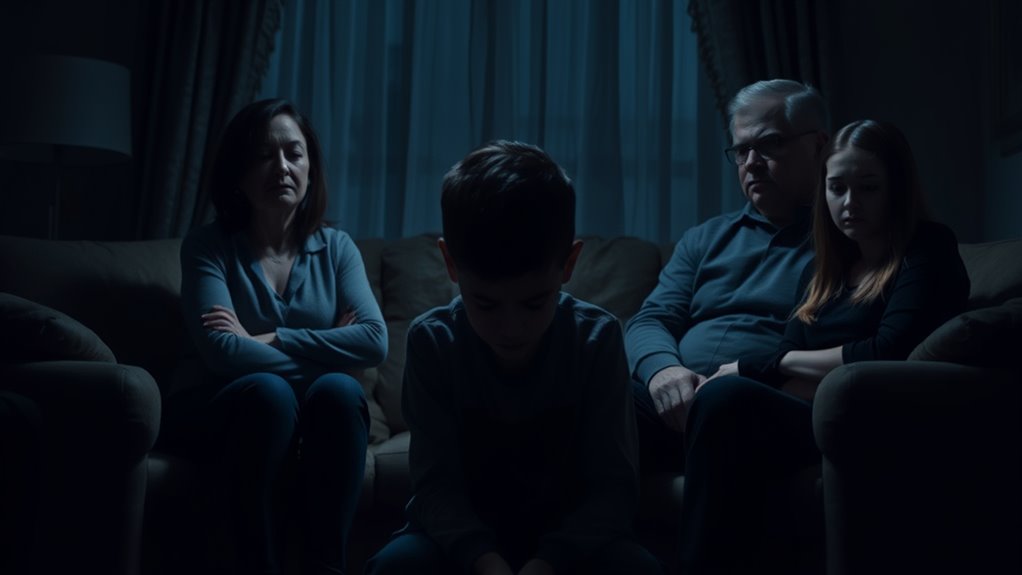Family gaslighting messes with your perception within family dynamics, leaving you feeling confused and self-doubting. Gaslighters use tactics like denying emotions, blaming, and isolating you from support. This leads to emotional turmoil, making you question your reality. Bystanders can either help or worsen the situation, depending on their response. Recognizing these patterns is key for healing and reclaiming your truth. Discovering effective strategies can empower you to foster healthier family communication and relationships.
Key Takeaways
- Family gaslighting involves manipulation by loved ones, leading to emotional exhaustion and confusion for victims.
- Common tactics include denial of reality, blame-shifting, and emotional withholding, which distort perception.
- Gaslighters often create divisions within families, undermining trust and fostering emotional dependency.
- Victims experience self-doubt, isolation, and anxiety, necessitating coping strategies like therapy and boundary setting.
- Bystanders play a crucial role in validating victims’ feelings and disrupting gaslighting behaviors, promoting healthier family dynamics.
Understanding Family Gaslighting

Have you ever felt like your reality was being twisted by those closest to you? This unsettling experience often stems from family gaslighting, where loved ones manipulate your perception to maintain control. Family loyalty can complicate matters, making it tough to acknowledge the emotional harm being done. You might find yourself questioning your feelings or memories, all in the name of keeping peace or adhering to familial expectations. Establishing emotional boundaries is vital; it allows you to protect your mental well-being while still honoring your relationships. Recognizing the signs of family gaslighting can help you reclaim your narrative, empowering you to stand firm in your truth without compromising your emotional health. Don’t let loyalty blind you to the need for self-care. Additionally, the long-term economic costs of wood-burning practices can mirror the emotional toll of gaslighting, highlighting the importance of making informed choices for your well-being.
Common Tactics Used in Gaslighting

When you experience family gaslighting, you might notice denial of reality as a common tactic. This often comes hand in hand with manipulative communication styles that leave you questioning your own perceptions. Understanding the underlying dynamics of trustworthiness in relationships can help you recognize these strategies and impact your relationships and sense of self. Additionally, understanding the importance of diversification in your investments can help build resilience against emotional turmoil. For instance, just as electric bikes offer various features to enhance performance, recognizing different gaslighting tactics can empower you to navigate these challenging dynamics more effectively. Many of these tactics parallel emotional depth found in animated films, illustrating how complex narratives can reveal underlying psychological truths. Furthermore, acknowledging the need for environmental considerations in your interactions can promote healthier relationships and self-awareness.
Denial of Reality
Gaslighting often manifests through the denial of reality, where manipulators distort facts to undermine your perceptions. You might find yourself questioning what you know to be true due to their denial tactics. Here are some common strategies they use to create reality distortion:
- Downplaying your feelings: They dismiss your emotions, suggesting you’re overreacting or being too sensitive. This can lead to a significant impact on your emotional well-being as you begin to doubt your own feelings. In extreme cases, this can escalate to high volatility risks that affect your mental health. Additionally, prolonged emotional distress can manifest in physical symptoms, similar to those experienced during pregnancy changes. Just as color accuracy is vital for a true representation of images in projectors, your feelings deserve to be acknowledged and validated.
- Contradicting your memories: They insist that events happened differently, making you doubt your recollection.
- Feigning ignorance: They act as if they don’t remember conversations or incidents, leaving you feeling confused.
- Projecting blame: They accuse you of lying or being irrational, shifting the focus away from their behavior.
Recognizing these tactics can help you reclaim your sense of reality and strengthen your boundaries. Additionally, practicing dynamic communication exercises can foster a safer environment for expressing feelings and addressing gaslighting behaviors.
Manipulative Communication Styles
Manipulative communication styles often surface in family dynamics, where certain tactics can make you feel powerless or confused. One common tactic is passive aggression, where instead of expressing their feelings directly, a family member might use sarcasm or subtle jabs. This leaves you questioning their true intentions and feeling frustrated. Another tactic is emotional withholding, where someone deliberately withholds affection or support to manipulate your emotions. You might find yourself constantly trying to earn their approval or affection, feeling like you’re walking on eggshells. Recognizing these styles is vital; they distort communication and create an unhealthy environment. Narcissistic tendencies can exacerbate these manipulative behaviors, leading to a cycle of emotional abuse within the family. Furthermore, fostering a digital-friendly environment can help you develop a more resilient sense of self-worth, enabling you to better navigate these toxic dynamics. Additionally, understanding the importance of skin health can help you develop a more resilient sense of self-worth, enabling you to better navigate these toxic dynamics. A focus on healthy breakfast choices can also improve your overall well-being, making it easier to handle stress. Incorporating self-care practices, such as using glycolic acid for skin health, can enhance your overall confidence and resilience. By identifying these patterns, you can start to reclaim your voice and set boundaries, fostering healthier interactions within your family.
The Role of the Gaslighter

When you recognize gaslighting behaviors, it becomes easier to see how psychological manipulation shapes family dynamics. The gaslighter often uses subtle tactics to maintain control and distort reality. Understanding their role can help you break free from these harmful patterns. Embracing community spirit through supportive relationships can be a vital step in overcoming the impact of gaslighting. Engaging in effective relaxation techniques can also provide essential tools for managing stress and anxiety associated with these situations. Incorporating music therapy into your routine may enhance emotional well-being and aid in processing these experiences. Additionally, fostering curiosity and happiness can empower you to explore new perspectives and build resilience. Utilizing analytical cookies on platforms that offer support can also help you track your emotional responses and personal growth over time.
Identifying Gaslighting Behaviors
Although it can be hard to spot, recognizing gaslighting behaviors is essential for maintaining your mental health. Gaslighters often employ tactics that undermine your reality, so knowing the signs is key. Here are some common behaviors to look for:
- Emotional Denial: They dismiss your feelings, insisting you’re overreacting or imagining things.
- Blame Shifting: They deflect responsibility by blaming you for their actions or feelings.
- Selective Memory: They conveniently forget events or details, making you question your recollection.
- Undermining Confidence: They subtly criticize you, eroding your self-esteem and making you doubt yourself.
Furthermore, understanding the importance of self-reliance in survival can help you build the confidence needed to confront gaslighting behaviors effectively.
Psychological Manipulation Techniques
Gaslighters often employ a range of psychological manipulation techniques to maintain control over their victims. They use tactics like denial, misdirection, and blame-shifting to distort your reality. By undermining your emotional boundaries, they create confusion, making it harder for you to trust your instincts. You might find yourself second-guessing your feelings and memories, which only strengthens their grip on you. This manipulation erodes your sense of self, making trust rebuilding seem intimidating. To reclaim your power, you must recognize these tactics and establish firm emotional boundaries. Acknowledging your experiences helps you regain clarity and confidence, paving the way for healthier relationships built on mutual respect and trust.
Impact on Family Dynamics
How does a gaslighter influence family dynamics? A gaslighter disrupts the harmony within a family, leading to confusion and conflict. Their behavior can create significant family role confusion and blur emotional boundaries, leaving members uncertain of their positions and feelings. Here are four ways a gaslighter impacts family dynamics:
- Manipulative Communication: They twist words and events, causing doubt and mistrust among family members.
- Isolation Tactics: They may pit family members against each other, creating divisions.
- Emotional Dependency: They foster reliance on their approval, undermining self-esteem and autonomy.
- Boundary Violations: They dismiss personal limits, making it hard for others to assert themselves.
In this toxic environment, healing becomes challenging, and relationships suffer.
The Victim’s Experience

Many victims of family gaslighting feel trapped in a web of confusion and self-doubt. You often question your reality, leading to emotional turmoil and a struggle for self-identity. Establishing emotional resilience becomes essential, as does learning effective boundary setting. You might find yourself oscillating between wanting to please your family and feeling the need to protect your mental health.
| Emotional Impact | Coping Strategies |
|---|---|
| Self-Doubt | Journaling to clarify thoughts |
| Confusion | Seeking therapy for guidance |
| Isolation | Building a support network |
| Anxiety | Practicing mindfulness |
Recognizing these patterns can empower you to reclaim your sense of self and foster healthier family dynamics.
Bystanders and Their Impact

What role do bystanders play in the dynamics of family gaslighting? Bystanders can substantially influence the situation, either positively or negatively. Their intervention can help shift the balance of power and support the victim. Here are four ways bystanders impact family gaslighting:
- Validation: Bystanders can validate the victim’s feelings, reinforcing that their experiences are real and important.
- Support: They can offer emotional support, creating a safe space for the victim to express themselves.
- Intervention: Engaging in bystander intervention can disrupt the gaslighting behavior and challenge the abuser.
- Awareness: By fulfilling family witness roles, bystanders can raise awareness about unhealthy dynamics, fostering a healthier family environment.
Your involvement can either perpetuate or mitigate the effects of gaslighting within the family.
Identifying Gaslighting Patterns

While you may not always recognize it at first, identifying gaslighting patterns within your family can be essential for your emotional well-being. Pay attention to recurring behaviors that undermine your reality or feelings. Look for family secrets that are often used to manipulate perceptions, keeping you in a state of confusion. Establishing emotional boundaries is critical; without them, you may find yourself trapped in a cycle of doubt.
| Gaslighting Behavior | Impact on You |
|---|---|
| Dismissing your feelings | Creates self-doubt |
| Blaming you for family issues | Erodes your self-esteem |
| Denying past events | Confuses your sense of reality |
| Isolating you from support | Increases dependency on gaslighter |
Consequences of Family Gaslighting

Recognizing gaslighting patterns in your family is just the beginning; understanding the consequences is equally important. The impact of family gaslighting can be profound, leading to several significant issues in your life:
Recognizing family gaslighting is just the start; understanding its profound consequences is crucial for your healing journey.
- Emotional Exhaustion: Constant doubt and confusion drain your energy, leaving you feeling mentally and physically fatigued.
- Trust Erosion: You may struggle to trust not only your family but also yourself, questioning your perceptions and instincts.
- Isolation: As you start to feel misunderstood, you might withdraw from relationships, believing no one can support you.
- Anxiety and Depression: The ongoing conflict and invalidation can trigger mental health issues, making it hard to cope with daily life.
Recognizing these consequences is vital for your healing journey.
Strategies for Addressing Gaslighting

Addressing gaslighting in your family requires a proactive approach, as you need to reclaim your sense of reality and self-worth. First, establish clear emotional boundaries. Let your family know what behaviors are unacceptable and how they impact you. Communicate your feelings assertively, ensuring they understand the consequences of their actions. Next, practice conflict resolution techniques. Stay calm during disagreements, focusing on facts rather than emotions. Encourage open dialogue, allowing everyone to express their perspectives without judgment. Seek support from trusted friends or professionals if needed, and prioritize your mental well-being. Remember, you deserve to feel validated and secure in your relationships. Taking these steps will empower you to confront gaslighting effectively and foster healthier family dynamics.
Fostering Healthy Communication in Families

Healthy communication is the backbone of any strong family relationship. To foster this, focus on key practices that promote understanding and respect. Here are four effective strategies:
- Set Boundaries: Clearly communicate your personal limits to create a safe space for everyone.
- Practice Active Listening: Show genuine interest in family members’ feelings and thoughts without interrupting or judging.
- Offer Emotional Validation: Acknowledge each other’s feelings, even if you don’t agree. This validates their experiences and strengthens your bond.
- Encourage Open Dialogue: Create an environment where everyone feels comfortable sharing their thoughts, fostering transparency and trust.
Frequently Asked Questions
Can Gaslighting Occur in Non-Familial Relationships?
Yes, gaslighting can definitely occur in non-familial relationships. You might experience emotional manipulation from friends, partners, or colleagues, leading to trust erosion. When someone consistently undermines your feelings or perceptions, it creates confusion and self-doubt. It’s essential to recognize these behaviors, as they can harm your well-being. Surround yourself with supportive people who validate your experiences, helping you rebuild your confidence and restore healthy boundaries.
Are There Cultural Differences in Gaslighting Behaviors?
Yes, there are cultural differences in gaslighting behaviors. In some cultures, social norms might make it easier for individuals to dismiss or deny experiences, leading to cultural denial. You might notice that in certain societies, people are pressured to conform, which can amplify gaslighting. Understanding these cultural dynamics helps you identify gaslighting’s nuances and recognize how different backgrounds influence interpersonal interactions. It is crucial to approach these situations with sensitivity and awareness.
What Is the Long-Term Impact of Family Gaslighting?
The long-term impact of family gaslighting can be profound. You might struggle with emotional resilience, finding it hard to trust your feelings or perceptions. This erosion of self-awareness can lead to difficulties in relationships and decision-making. Over time, you may experience anxiety or depression, as your sense of reality feels distorted. It’s essential to seek support, develop emotional tools, and rebuild your self-awareness to counteract these damaging effects and regain your confidence.
How Can Therapy Help Victims of Gaslighting?
Therapy can be like a lighthouse in a stormy sea, guiding you to safety. It helps you navigate emotional healing by providing a safe space to process your experiences. You’ll learn coping strategies to manage the confusion and doubt gaslighting creates. With a therapist, you can rebuild your sense of self, establish boundaries, and regain control over your life. This journey empowers you to find clarity and peace amidst the chaos.
Can Children Become Gaslighters as Adults?
Yes, children can become gaslighters as adults. If they grow up in an environment where manipulation is common, they might adopt these behaviors. Childhood influences shape your understanding of relationships, and if you’re exposed to gaslighting, you may replicate it unconsciously. As an adult, this can manifest as manipulation in your own relationships. It’s essential to recognize these patterns and seek help to break the cycle and foster healthier interactions.
Conclusion
In steering the turbulent waters of family gaslighting, you hold the compass to steer your relationships toward healthier shores. By recognizing patterns and addressing the tactics used, you can reclaim your voice and foster open communication. Remember, like a garden that flourishes with care, your family dynamic can thrive when nurtured with honesty and respect. Don’t let the shadows of gaslighting dim your light; instead, shine brightly and cultivate a space of trust and understanding.









